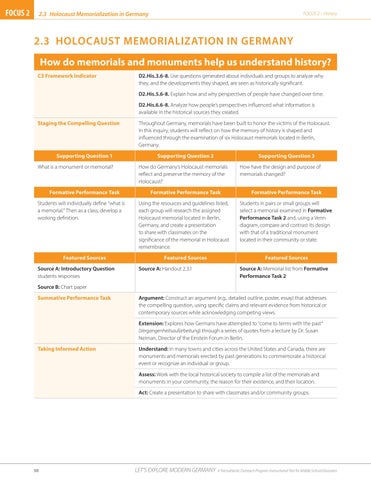FOCUS 2
2.3 Holocaust Memorialization in Germany
FOCUS 2 – History
2.3 HOLOCAUST MEMORIALIZATION IN GERMANY How do memorials and monuments help us understand history? C3 Framework Indicator
D2.His.3.6-8. Use questions generated about individuals and groups to analyze why they, and the developments they shaped, are seen as historically significant. D2.His.5.6-8. Explain how and why perspectives of people have changed over time. D2.His.6.6-8. Analyze how people’s perspectives influenced what information is available in the historical sources they created.
Staging the Compelling Question
Supporting Question 1 What is a monument or memorial?
Formative Performance Task Students will individually define “what is a memorial.” Then as a class, develop a working definition.
Featured Sources Source A: Introductory Question students responses
Throughout Germany, memorials have been built to honor the victims of the Holocaust. In this inquiry, students will reflect on how the memory of history is shaped and influenced through the examination of six Holocaust memorials located in Berlin, Germany. Supporting Question 2
Supporting Question 3
How do Germany’s Holocaust memorials reflect and preserve the memory of the Holocaust?
How have the design and purpose of memorials changed?
Formative Performance Task
Formative Performance Task
Using the resources and guidelines listed, each group will research the assigned Holocaust memorial located in Berlin, Germany, and create a presentation to share with classmates on the significance of the memorial in Holocaust remembrance.
Students in pairs or small groups will select a memorial examined in Formative Performance Task 2 and, using a Venn diagram, compare and contrast its design with that of a traditional monument located in their community or state.
Featured Sources
Featured Sources
Source A: Handout 2.3.1
Source A: Memorial list from Formative Performance Task 2
Source B: Chart paper Summative Performance Task
Argument: Construct an argument (e.g., detailed outline, poster, essay) that addresses the compelling question, using specific claims and relevant evidence from historical or contemporary sources while acknowledging competing views. Extension: Explores how Germans have attempted to “come to terms with the past” (Vergangenheitsaufarbeitung) through a series of quotes from a lecture by Dr. Susan Neiman, Director of the Einstein Forum in Berlin.
Taking Informed Action
Understand: In many towns and cities across the United States and Canada, there are monuments and memorials erected by past generations to commemorate a historical event or recognize an individual or group. Assess: Work with the local historical society to compile a list of the memorials and monuments in your community, the reason for their existence, and their location. Act: Create a presentation to share with classmates and/or community groups.
50
LET’S EXPLORE MODERN GERMANY
A Transatlantic Outreach Program Instructional Text for Middle School Educators





















